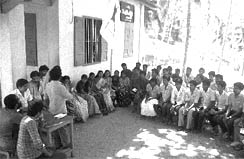A welcome drop
 THE southern state of Kerala has performed extraordinarily in the areas of public health, education, family welfare and adult literacy. Its success in areas other than population control are easier to understand, but its miracle in bringing down birth rate below replacement level without any significant advance in economic field defies explanation in conventional terms.
THE southern state of Kerala has performed extraordinarily in the areas of public health, education, family welfare and adult literacy. Its success in areas other than population control are easier to understand, but its miracle in bringing down birth rate below replacement level without any significant advance in economic field defies explanation in conventional terms.
Kerala has been one of the less prosperous states in the country. Conventional belief is that a decline in birth rate is followed by urbanisation and industrialisation. However, these two factors did not play any role of significance in Kerala's demographic transition. Kerala's Demographic Transition Determinants And Consequences, a collection of seminar papers edited by K C Zachariah and Irudaya Rajan tries to understand the determinants of demographic change and its consequences.
The book provides an insight into factors that have brought about Kerala's demographic transition. These include pro-people policies of the state, higher standards of health, high literacy rate, relatively higher age at marriage compared to other states of India, and the use of contraceptives. Added to these are internal and external migration.
In Kerala, better education, combined with appropriate state policies brought down the level of infant mortality to 13 per thousand (1993 figures), which is an extraordinary achievement by any standards. Besides infant mortality, the overall mortality figures have also been brought down. It may not have been too difficult to achieve this for a state where mortality has always been lower than in other areas of the country.
Kerala's case is more interesting in the sense that till the mid-1960s, its fertility rate was among the highest and its mortality rate among the lowest in the country. However, drastic reductions in fertility began in the mid-1960s when family planning practices began to take root. "The birth rate which was hovering above 40 until 1965 declined to about 35 by 1970. The pace of decline in the fertility rates accelerated in the 1970s and by the end of the decade the birth rate had declined to below 30'. The birth rate continues to fall every year. This in short, is Kerala's success story of population control.
The decline in mortality and fertility rate may change the age-sex structures. A time may come when those people who are retiring and who need support from state and society would outnumber the working, young population. "Children may become rare in the state. Industries catering to the needs of children are going to have a bleak future. Many schools are already empty, but a much worse situation can be expected in future...' The editors note that for every 100 people in the working age group of 20-59, there were only 16 old people in 1991. They predict that "this ratio would have increased to 60 by the year 2031'. "The sooner we prepare ourselves for these changes, the better we will be equipped to meet the challenge.'
According to the editors, the dramatic reduction in fertility was partly due to the fall in infant mortality. Earlier, people opted for several children fearing that some of them may not survive. With fewer infant deaths, couples did not have a major motivating factor for having a number of children. Women's education facilitated health care programmes such as immunisation against childhood diseases and also increased the number of medically-supervised deliveries. They observe that a well executed mother-child health care programme can go a long way in reducing fatality in other states of India as well.
Notwithstanding a few banal observations, the book makes interesting reading. For instance, one does not need to read a book on Kerala's demographic change to know that families whose members were working in Saudi Arabia during the Gulf war used to listen to the news on their radio sets. It is obvious that a woman whose relation is working in a war-torn country would listen to the news. Mercifully, there are only a few instances of such "research' in the book.
